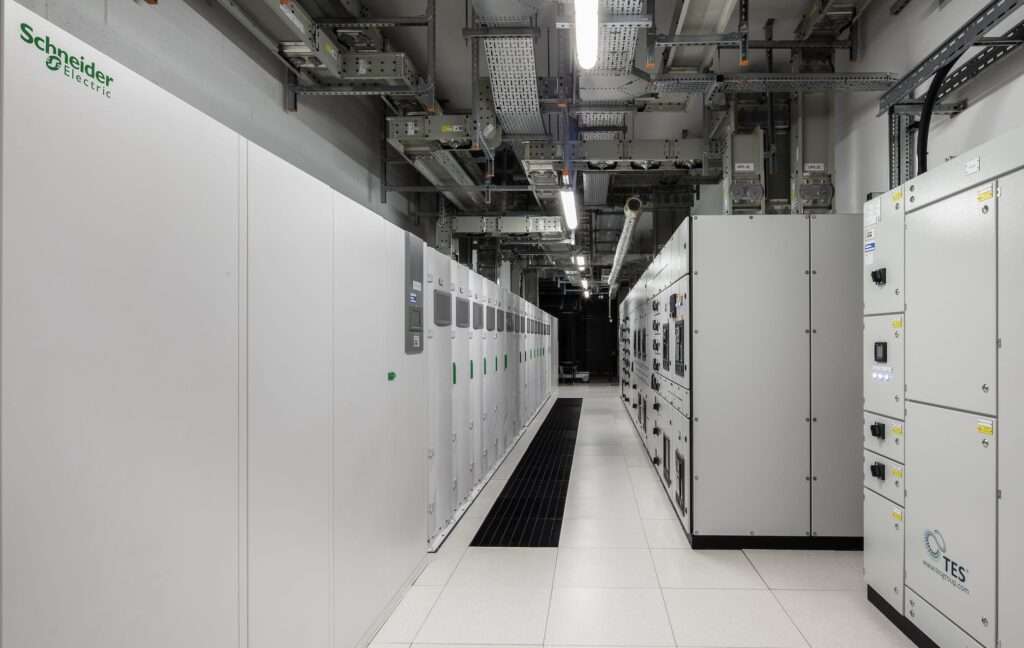In the heart of Silicon Valley, two newly constructed data centers — designed to house the most voracious computing clusters of the AI era — remain empty. Digital Realty’s SJC37, a four-story building with 48 MW of critical load, and STACK Infrastructure’s SVY02A campus, also designed for 48 MW with an own substation and eight rooms, are completed… but without power available for operation. Bloomberg has reported this, warning that both complexes “may remain vacant for years” while the local power grid is reinforced.
What’s happening in Santa Clara
The city operates under a municipal electric company, Silicon Valley Power (SVP), which cannot keep pace with the surge in demand from data center operators. According to the city, there are 57 active or developing facilities, and the public utility is executing a $450 million expansion plan — involving new substations and lines — scheduled to conclude by 2028. Until then, power will be allocated in phases as infrastructure comes online.
The issue isn’t the buildings — they are already built — but the “time-to-power” (time until power is available). Alongside the AI boom, new training and inference clusters double rack density, raising campus demand to tens or hundreds of megawatts, a scale that stresses urban transmission and distribution. Santa Clara’s case highlights a pattern that repeats across major US colocation markets — from northern Virginia to Phoenix: construction of buildings finishes before the grid work is complete.
The two “waiting for power” projects
- Digital Realty SJC37 (641 Walsh Ave.): 430,000 sq ft (around 40,000 m²), four floors, designed for 48 MW. The company promotes it as part of its Silicon Valley campus, with metro interconnection and direct access to clouds and carriers, but its full energization depends on SVP’s schedule.
- STACK Infrastructure SVY02A (Santa Clara): 48 MW campus with a local substation and eight technical rooms. Marketed as “ready for high density,” though final energization is coordinated with SVP.
Both companies have indicated that they are working with the electric company to phase the power delivery as network work progresses. There is no firm date for complete energization.
Why it matters (beyond California)
Santa Clara is a strategic territory: proximity to major AI development ecosystems and end users demanding low latency. In fact, the two paused sites are just minutes from NVIDIA’s headquarters, exemplifying how hardware can advance much faster than the electric infrastructure that powers it.
Nationwide, the picture is similar: hyperscalers and colocation operators will demand 22% more grid energy by the end of 2025 and nearly triple it by 2030, according to S&P Global, forcing the acceleration of transmission permits, new substations, and plant efficiency measures.
The “building vs. grid” bottleneck: how to close the gap
Silicon Valley Power has outlined its roadmap: $450 million investments and sequencing of customer connections through 2028. Meanwhile, operators are exploring bridge solutions to reduce time-to-power: from power purchase agreements with renewables and BESS batteries to on-site generation (fuel cells, microgrids) and energy density improvements per rack and power profiles aligned with actual usage. An industry report from 2025 estimates a 35 GW power gap by 2030 that data centers will attempt to fill through a combination of new lines, flexible load, and distributed generation.
The regulatory and civil works bottleneck
Beyond CAPEX, timelines are driven by heavy electrical construction: towers, high-voltage lines, transformers, and environmental permits. In urban areas like Santa Clara, with a dense fabric of business parks and residential zones, planning for electrical easements and processing new substation permits add years to the schedule. That’s why the city urges patience from operators and reminds them that projects of this scale are inherently “fluid”.
What’s next?
In the short term, both buildings will remain empty or have partial loads. SVP’s plan aims for phased power deliveries as milestones are achieved between 2026 and 2028. In the medium term, Santa Clara aims to maintain its leadership as a data center hub on the West Coast, but developers are already diversifying into markets with available energy (Nevada, Oregon, Arizona) to keep the AI ramp-up moving. Long term, the solution lies in more grid, more storage, and greater efficiency per watt for GPU farms.
Quick facts
- Two completed data centers in Santa Clara (SJC37 by Digital Realty and SVY02A by STACK) cannot open due to lack of available power. Each: 48 MW. Total: ~100 MW.
- SVP is executing a $450M network upgrade plan with completion expected by 2028; energy will be delivered in phases as substations and lines come online.
- The energy demand for data centers in the US rises 22% in 2025 and could triple by 2030, straining transmission systems.
- Silicon Valley remains attractive due to low latency and ecosystem, but the gap between civil and electrical work widens as AI explodes.
Frequently Asked Questions
Why can’t they just “run a cable” and be done?
To supply ~100 MW, substations and often new high-voltage lines are required; these projects involve environmental permits, urban procedures, and multi-year timelines. That’s why ready-built buildings are waiting for the grid to catch up.
How long will it take to resolve?
SVP estimates 2028 for its expansion plan, with intermediate phased allocations. Until then, expect partial loads or delays.
Are temporary on-site energy solutions being used?
The sector explores BESS batteries, fuel cells, and microgrids as bridges to reduce time-to-power, plus optimization of power profiles per load. These don’t replace large-scale grid power but shorten times and enhance resilience.
Is this specific to Silicon Valley or a global issue?
It’s a global challenge affecting major data center markets. AI accelerates demand, and many cities cannot energize at the pace of construction. Silicon Valley’s situation is visible due to its density and project volume.
Sources: Bloomberg — Data Centers in Nvidia’s Hometown Stand Empty Awaiting Power (11/10/2025); data sheets from Digital Realty SJC37 and STACK SVY02; S&P Global (via Data Center Dynamics) on data center electricity demand.

